Deep-Sea Convergence Zone Parameter Prediction with Non-Uniform Mixed-Layer Sound Speed Profiles
Abstract
1. Introduction
- A method for constructing horizontally inhomogeneous sound speed profiles in the deep-sea mixed layer is proposed. By using EOF decomposition technology to extract the spatial model characteristics of temperature and salinity fields and combining them with the Del Grosso formula, a three-dimensional continuous sound speed field is generated.
- A ray-tracing algorithm based on non-uniformly distributed sound speed profiles is developed. By introducing the horizontal sound speed gradient term into the ray equation and designing a fourth-order Runge–Kutta numerical solution algorithm, the bottleneck of traditional ray models in representing the influence of horizontal sound speed gradients is overcome, thereby improving the prediction accuracy of convergence zone ray trajectories.
- The algorithm for forecasting convergence zone characteristic parameters is validated using environmental parameters from a representative marine area. The findings indicate that the algorithm successfully accounts for the forward displacement of the convergence zone induced by the horizontal gradient of sound speed within the mixed layer, thereby enhancing the forecast’s accuracy.
2. Analysis of the Non-Uniform Sound Speed Profile in the Deep-Sea Mixed Layer
2.1. Analysis of Factors Affecting Sound Speed in the Mixed Layer
2.1.1. The Effect of Temperature on Sound Speed
2.1.2. The Effect of Salinity on Sound Speed
2.1.3. The Effect of Pressure on the Speed of Sound
2.2. Construction of Non-Uniform Sound Speed Profiles
2.2.1. Data Acquisition and Preprocessing
2.2.2. Modeling the Horizontal and Vertical Distribution of Temperature and Salinity
2.2.3. Del Grosso Acoustic Velocity Coupling
3. Prediction of Characteristic Parameters of the Deep-Sea Convergence Zone
3.1. Ray Equations Considering the Mixed-Layer Sound Speed Profile
3.2. Forecast of Convergence Zone Characteristic Parameters
| Algorithm 1 Improved sound ray-tracing algorithm for the ray model. | |||
| Input: Marine temperature dataset S, Marine salinity dataset T | |||
| Output: Sound ray position dataset | |||
| Set the source location , the initial grazing angle , the maximum propagation distance , the initial step size | |||
| while do | |||
| Read the temperature and salinity at the current point | |||
| Calculate the sound speed value: | |||
| Calculate the sound speed gradients and | |||
| for to 4 do | |||
| Calculate the first slope based on the current sound ray position | |||
| Using , half-step length and , calculate the second slope | |||
| Using , half-step length and , calculate the third slope | |||
| Using , step length and , calculate the fourth slope | |||
| Update the sound ray position : | |||
| Calculate the updated grazing angle : | |||
| end for | |||
| Accumulate the propagation distance | |||
| Store the new position of the sound ray | |||
| end while | |||
| return Outputs | |||
3.3. Computational Complexity Analysis
4. Simulation
4.1. Characteristic Features of Typical Marine Environment and Data Preparation
4.2. Simulation of Convergence Zone Characteristic Parameter Forecasting and Comparative Analysis of Results
5. Conclusions
- A modeling method for the horizontal non-uniform sound speed profile in the mixed layer is proposed. The spatial variation characteristics of the temperature and salinity fields are extracted by stratified empirical orthogonal functions and combined with the Del Grosso sound speed formula to generate a three-dimensional sound speed field. This method breaks through the limitation of the vertical stratification assumption and constructs a continuous sound speed profile model associated with horizontal distance and vertical depth.
- The construction of a ray model with horizontal gradient correction and the implementation of ray tracing are realized. A correction term for the horizontal gradient of sound speed is introduced into the classical ray equation, and the ray-tracing equation under non-uniform media is derived. A fourth-order Runge–Kutta numerical integration algorithm is designed to quantify the effect of the horizontal gradient on the curvature of the ray, achieving high-precision tracking of the ray trajectory and analysis of the energy-focusing characteristics, and significantly improving the ability to characterize the sound field in complex sea areas.
- The convergence zone characteristic parameter forecasting algorithm is applied and its effectiveness is verified in a typical sea area environment. Taking the South China Sea acoustic propagation experiment as the benchmark case, the forecasting performance of the Bellhop model, the method in this paper, and the measured data are compared. The experimental results show that when the sound source depth is 80 m, the frequency is 300 Hz, and the launch angle is ±10°, the first convergence zone distance forecasting error of the improved model is reduced by 2.26%, the width error is reduced by 2.66%, and the gain prediction deviation is improved by 5.85%.
Author Contributions
Funding
Data Availability Statement
Conflicts of Interest
References
- Zhao, D.; Liang, S.; Chen, P.; Hu, Y.; Dang, Y.; Li, Y.; Liang, R.; Guo, X. Design of Deep-Sea Imaging Sonar System with Universal-Scene Sparse Array. IEEE Trans. Instrum. Meas. 2025, 74, 4503315. [Google Scholar] [CrossRef]
- Li, Y.; Jia, N.; Huang, J.; Han, R.; Guo, Z.; Guo, S. Analysis of High-Frequency Communication Channel Characteristics in a Typical Deep-Sea Incomplete Sound Channel. Electronics 2023, 12, 4562. [Google Scholar] [CrossRef]
- Papkova, Y.I. Sound Fields in Marine Waveguides with a Heterogeneous Speed of Sound Along the Depth and Path. Mosc. Univ. Phys. Bull. 2021, 76, 157–166. [Google Scholar] [CrossRef]
- Bhatt, E.C.; Baggeroer, A.B.; Weller, R.A. Overflow waters in the western Irminger Sea modify deep sound speed structure and convergence zone propagation. J. Acoust. Soc. Am. 2024, 155, 1216–1229. [Google Scholar] [CrossRef] [PubMed]
- Wu, S.; Li, Z.; Qin, J.; Wang, M.; Li, W. The effects of sound speed profile to the convergence zone in deep water. J. Mar. Sci. Eng. 2022, 10, 424. [Google Scholar] [CrossRef]
- Ma, S.; Guo, X.; Zhang, L.; Lan, Q.; Huang, C. Riemannian geometric modeling of underwater acoustic ray propagation? application—Riemannian geometric model of convergence zone in deep ocean remote sound propagation. Acta Phys. Sin. 2023, 72, 044301. [Google Scholar] [CrossRef]
- Porter, M.B.; Bucker, H.P. Gaussian beam tracing for computing ocean acoustic fields. J. Acoust. Soc. Am. 1987, 82, 1349–1359. [Google Scholar] [CrossRef]
- Weishuai, X.; Zhang, L.; Hua, W. The Influential Factors and Prediction of Kuroshio Extension Front on Acoustic Propagation-Tracked. Arch. Acoust. 2023, 49, 95–106. [Google Scholar]
- Liu, Y.; Zhang, X.; Fu, H.; Qian, Z. Response of sound propagation characteristics to Luzon cold eddy coupled with tide in the Northern South China Sea. Front. Mar. Sci. 2023, 10, 1278333. [Google Scholar] [CrossRef]
- Ma, X.; Zhang, L.; Xu, W.; Li, M. Analysis of acoustic field characteristics of mesoscale eddies throughout their complete life cycle. Front. Mar. Sci. 2025, 11, 1471670. [Google Scholar] [CrossRef]
- Cheng, C.; Zheng, C.; Hong, X. A deep-sea direct sound ranging method based on effective sound velocity estimation for turning ray. JASA Express Lett. 2025, 5, 066001. [Google Scholar] [CrossRef]
- Jensen, F.B.; Kuperman, W.A.; Porter, M.B.; Schmidt, H.; Tolstoy, A. Computational Ocean Acoustics; Springer: Berlin/Heidelberg, Germany, 2011; Volume 2011. [Google Scholar]
- Porter, M.B. The Bellhop Manual and User’s Guide: Preliminary Draft; Technical Reports; Heat, Light & Sound Research, Inc.: La Jolla, CA, USA, 2011; Volume 260. [Google Scholar]
- Talha, R.M.; Farooq, M.A.; Khan, S.; Iqbal, K.; Ismail, M.A. Development of Oceanographic Acoustic Modelling Tools for Streamlined Transmission Loss Analysis. In Proceedings of the 2024 21st International Bhurban Conference on Applied Sciences and Technology (IBCAST), IEEE, Murree, Pakistan, 20–23 August 2024; pp. 694–700. [Google Scholar]
- Zhang, P.; Li, Z.; Wu, L.; Zhang, R.; Qin, J. Characteristics of convergence zone formed by bottom reflection in deep water. Acta Phys. Sin. 2019, 68, 014301. [Google Scholar] [CrossRef]
- Yang, Y.; Mao, Y.; Xie, R.; Hu, Y.; Nan, Y. A novel optimal route planning algorithm for searching on the sea. Aeronaut. J. 2021, 125, 1064–1082. [Google Scholar] [CrossRef]
- Xu, W.; Zhang, L.; Wang, H. Machine learning–based feature prediction of convergence zones in ocean front environments. Front. Mar. Sci. 2024, 11, 1337234. [Google Scholar] [CrossRef]
- Li, M.; Liu, Y.; Sun, Y.; Liu, K. Quantitative analysis and prediction of the sound field convergence zone in mesoscale eddy environment based on data mining methods. Acta Oceanol. Sin. 2024, 43, 110–120. [Google Scholar] [CrossRef]
- Ibebuchi, C.C.; Richman, M.B. Deep learning with autoencoders and LSTM for ENSO forecasting. Clim. Dyn. 2024, 62, 5683–5697. [Google Scholar] [CrossRef]
- Xu, W.; Zhang, L.; Li, M.; Ma, X.; Wang, H. A physics-informed machine learning approach for predicting acoustic convergence zone features from limited mesoscale eddy data. Front. Mar. Sci. 2024, 11, 1364884. [Google Scholar] [CrossRef]
- Zhang, W.; Jin, S.; Bian, G.; Peng, C.; Xia, H. A Method for Full-Depth Sound Speed Profile Reconstruction Based on Average Sound Speed Extrapolation. J. Mar. Sci. Eng. 2024, 12, 930. [Google Scholar] [CrossRef]
- Richards, E.L.; Colosi, J.A. Observations of ocean spice and isopycnal tilt sound-speed structures in the mixed layer and upper ocean and their impacts on acoustic propagation. J. Acoust. Soc. Am. 2023, 154, 2154–2167. [Google Scholar] [CrossRef]
- Wu, P.; Sun, J.; Shan, G.; Sun, Z.; Wei, P. Inversion of deep-water velocity using the munk formula and the seabed reflection traveltime: An inversion scheme that takes the complex seabed topography into account. IEEE Trans. Geosci. Remote Sens. 2023, 61, 4205014. [Google Scholar] [CrossRef]
- Yang, F.; Hu, T.; Wang, Z. Effects of sound velocity perturbations in the upper layer on the position of sound convergence zones in deep water. In Proceedings of the 2021 OES China Ocean Acoustics (COA), IEEE, Harbin, China, 14–17 July 2021; pp. 327–330. [Google Scholar]
- Del Grosso, V.A. New equation for the speed of sound in natural waters (with comparisons to other equations). J. Acoust. Soc. Am. 1974, 56, 1084–1091. [Google Scholar] [CrossRef]
- Wilson, W.D. Extrapolation of the equation for the speed of sound in sea water. J. Acoust. Soc. Am. 1962, 34, 866. [Google Scholar] [CrossRef]
- Kang, E.J.; Sohn, B.J.; Kim, S.W.; Kim, W.; Kwon, Y.C.; Kim, S.B.; Chun, H.W.; Liu, C. A revised ocean mixed layer model for better simulating the diurnal variation in ocean skin temperature. Geosci. Model Dev. 2024, 17, 8553–8568. [Google Scholar] [CrossRef]
- McDougall, T.J.; Jackett, D.R.; Wright, D.G.; Feistel, R. Accurate and computationally efficient algorithms for potential temperature and density of seawater. J. Atmos. Ocean. Technol. 2003, 20, 730–741. [Google Scholar] [CrossRef]
- Li, H.; Xu, F.; Zhou, W.; Wang, D.; Wright, J.S.; Liu, Z.; Lin, Y. Development of a global gridded A rgo data set with B arnes successive corrections. J. Geophys. Res. Ocean. 2017, 122, 866–889. [Google Scholar] [CrossRef]
- Obled, C.; Creutin, J. Some developments in the use of empirical orthogonal functions for mapping meteorological fields. J. Appl. Meteorol. Climatol. 1986, 25, 1189–1204. [Google Scholar] [CrossRef]
- Bahrami, N.; Khamis, N.H.H.; Baharom, A.; Yahya, A. Underwater channel characterization to design wireless sensor network by bellhop. TELKOMNIKA Telecommun. Comput. Electron. Control 2016, 14, 110–118. [Google Scholar] [CrossRef]
- Koyanagi, S.; Nakano, T.; Kawabe, T. Application of Hamiltonian of ray motion to room acoustics. J. Acoust. Soc. Am. 2008, 124, 719–722. [Google Scholar] [CrossRef]
- Zaki, A.; Bashir, B.; Alsalman, A.; Elsaka, B.; Abdallah, M.; El-Ashquer, M. Evaluating the Accuracy of Global Bathymetric Models in the Red Sea Using Shipborne Bathymetry. J. Indian Soc. Remote Sens. 2025, 53, 277–291. [Google Scholar] [CrossRef]
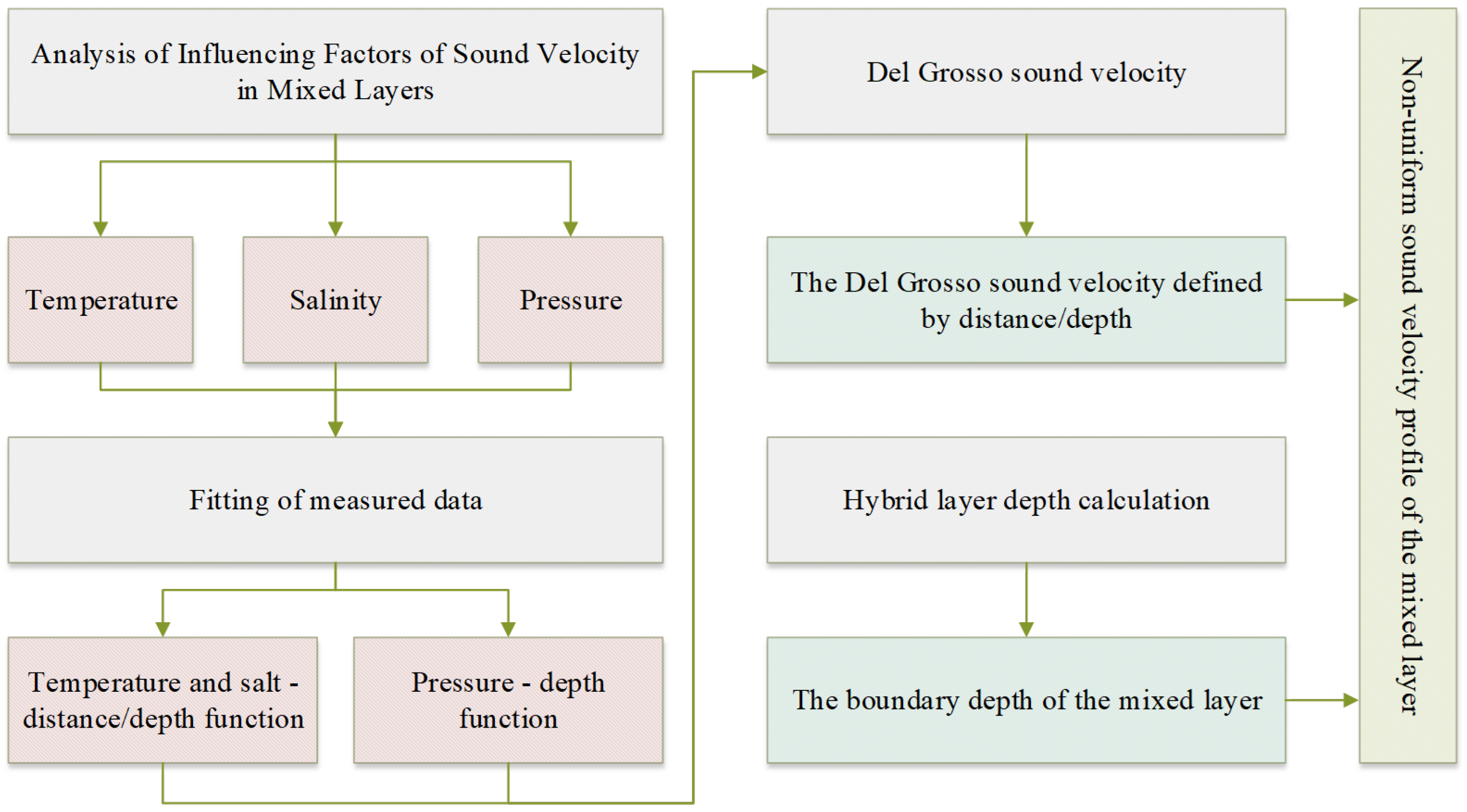

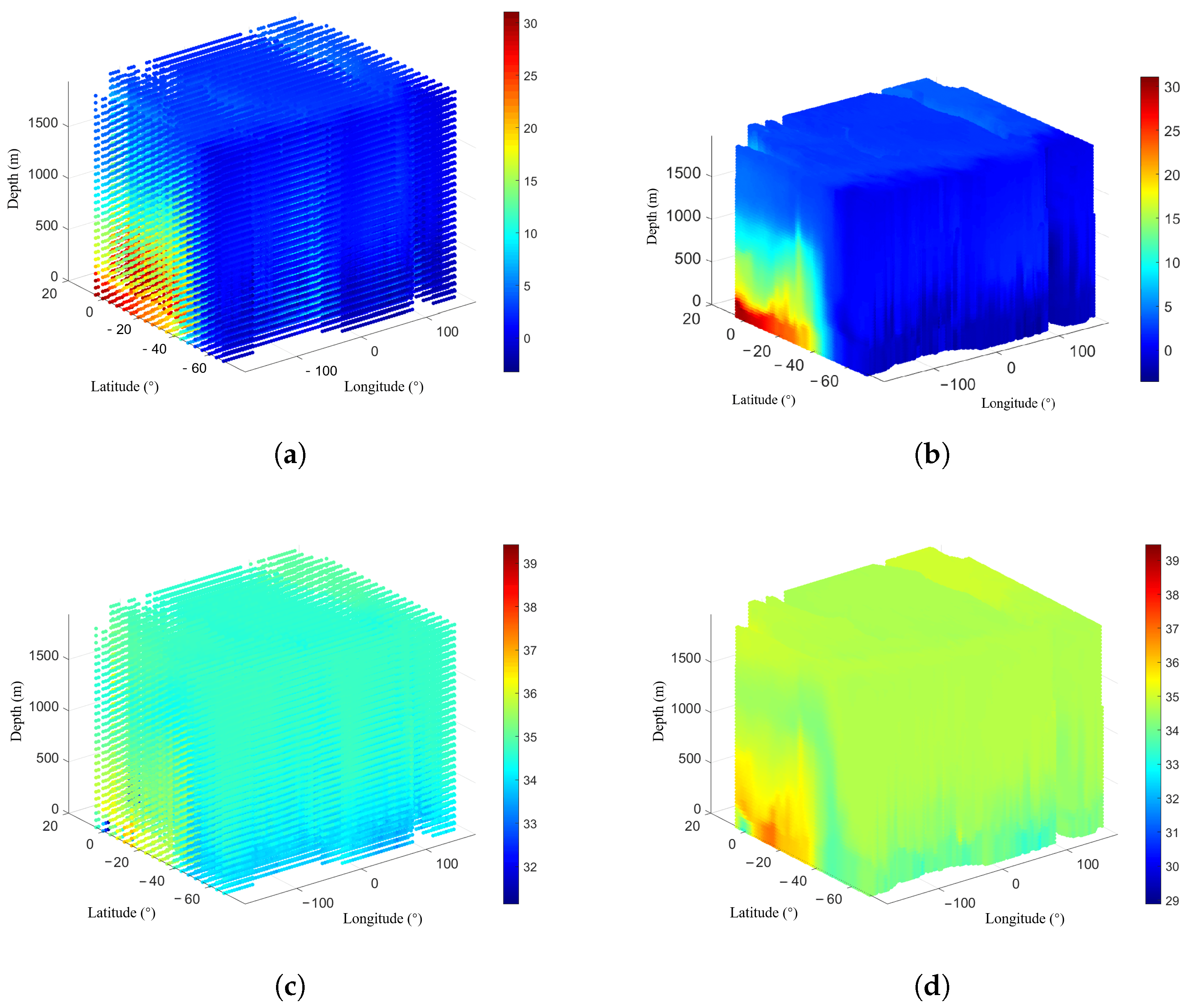
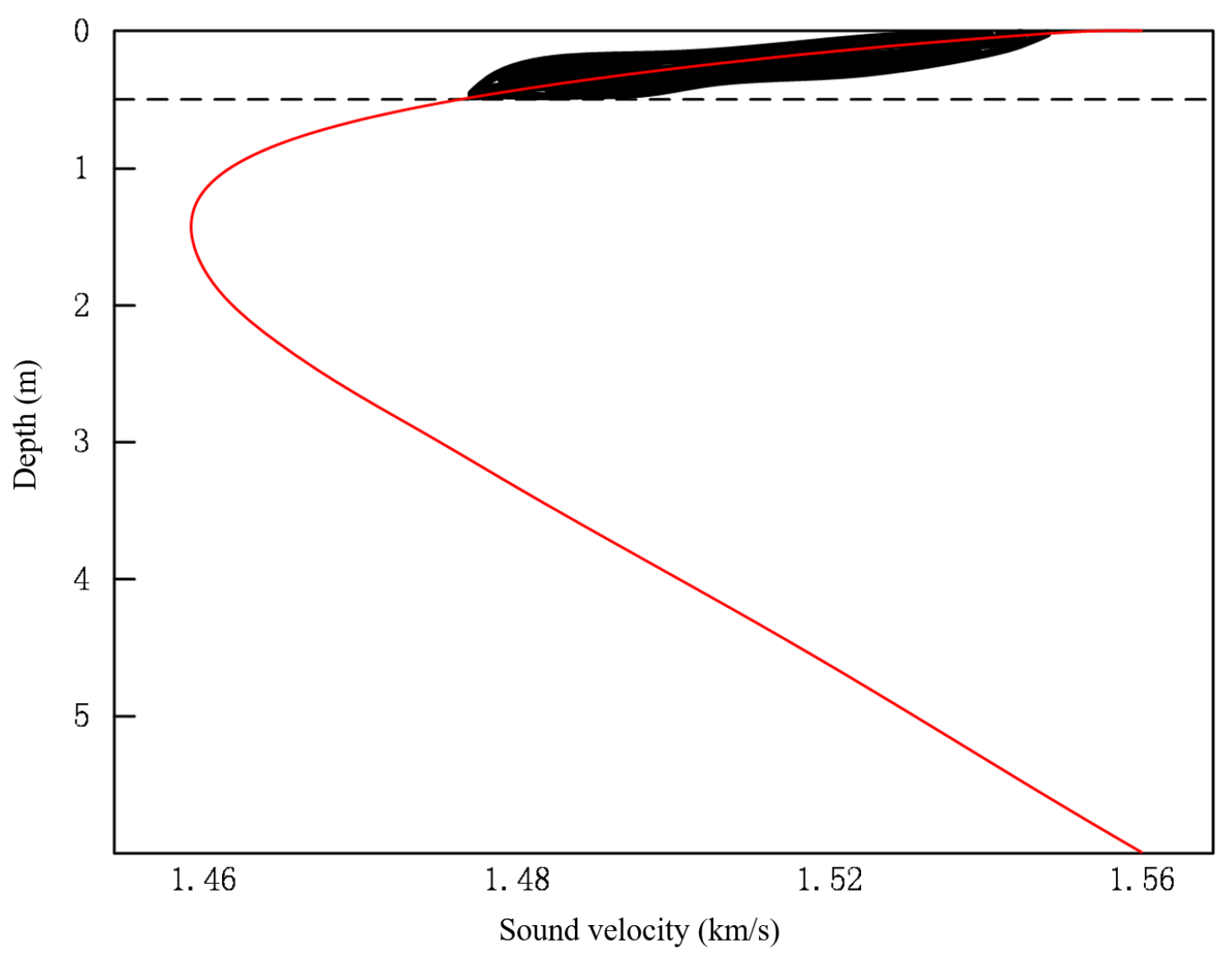
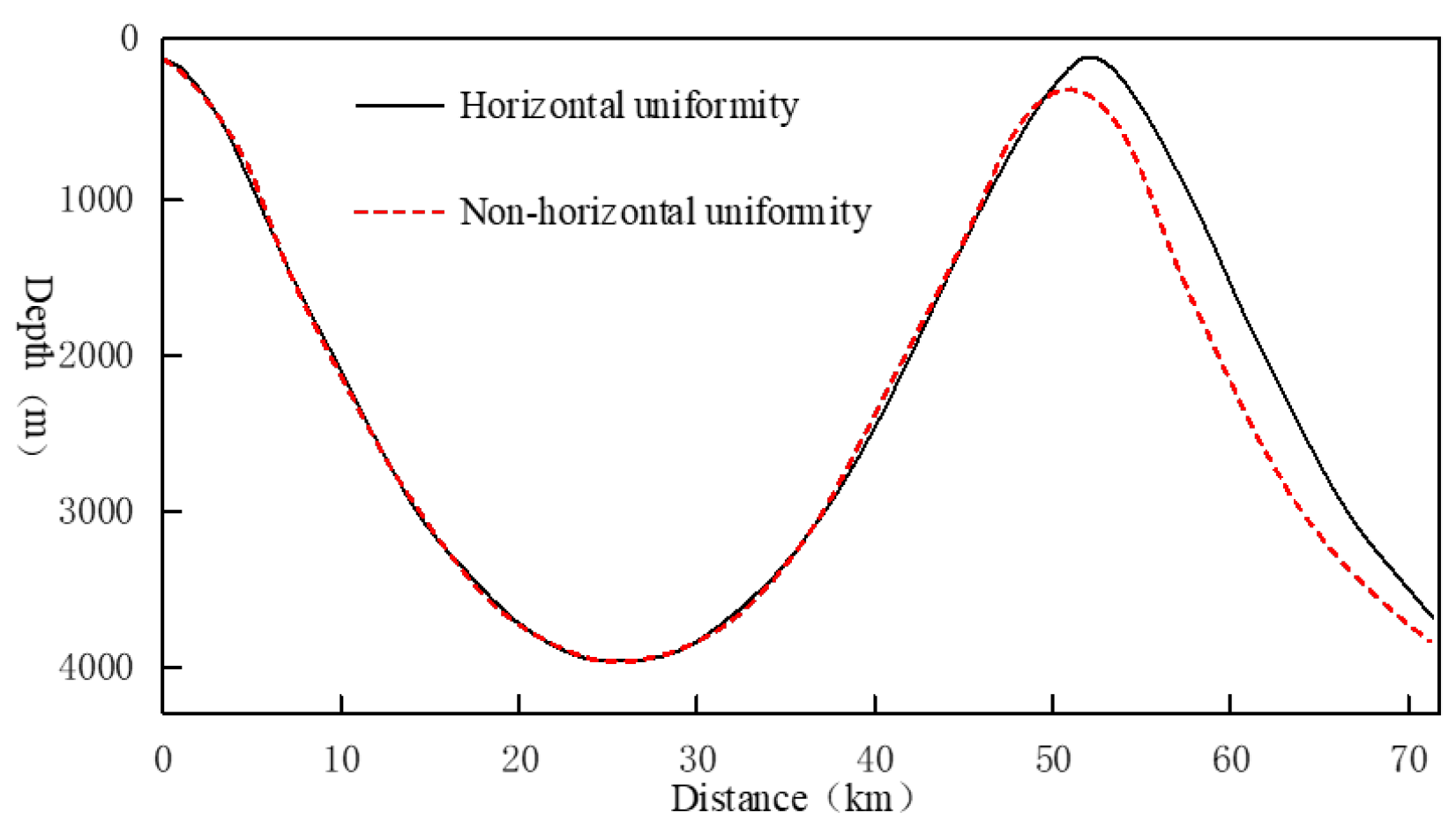
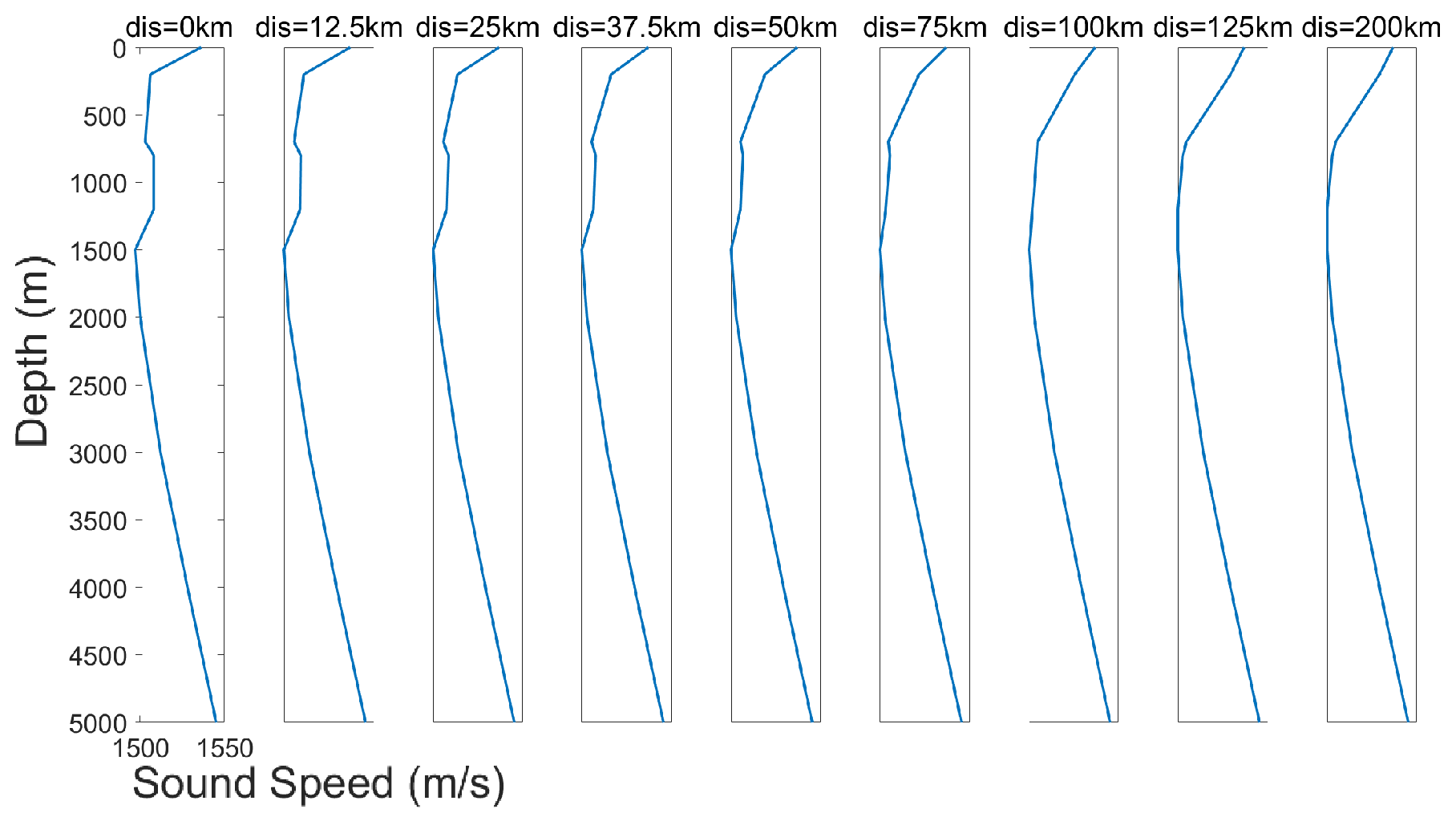
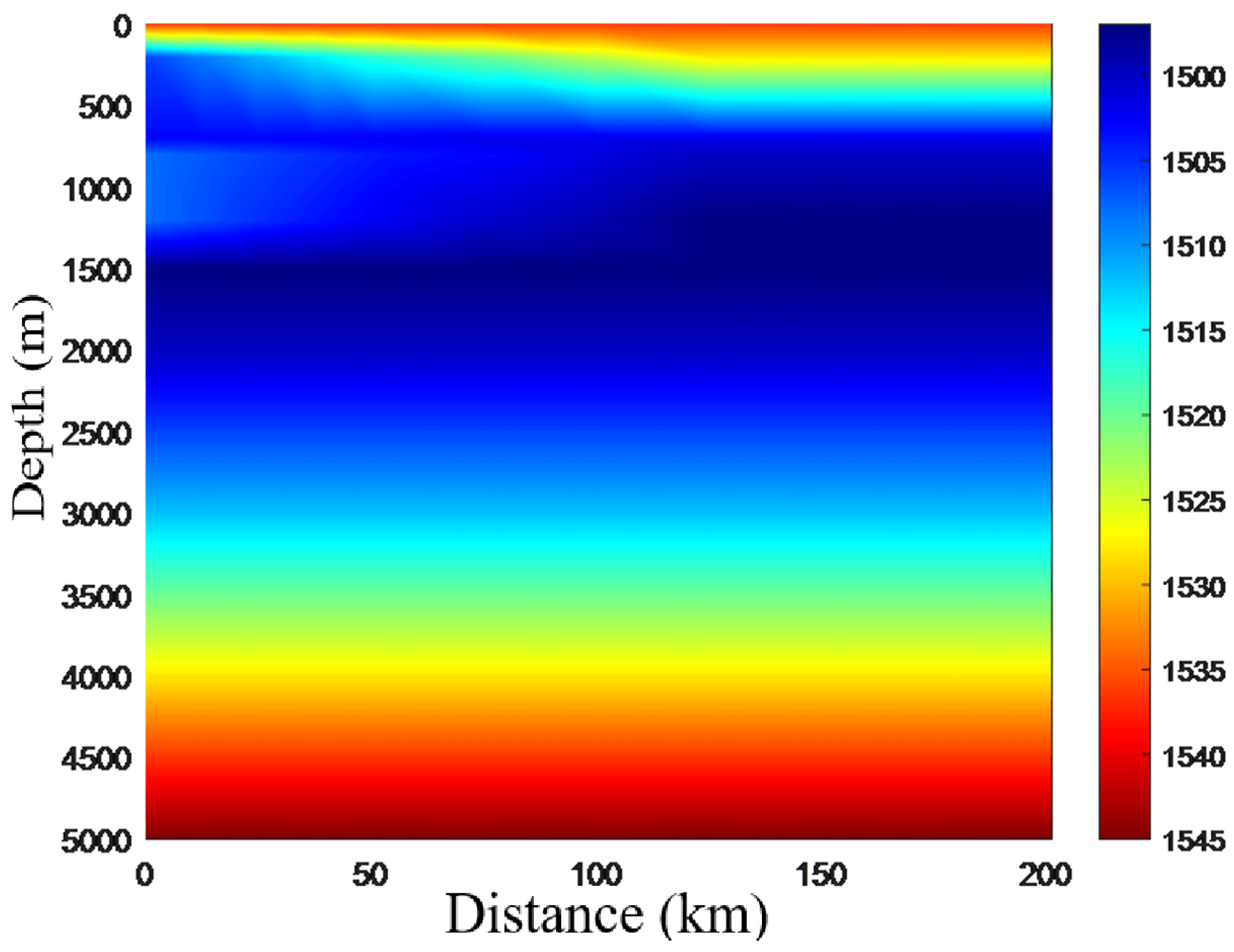
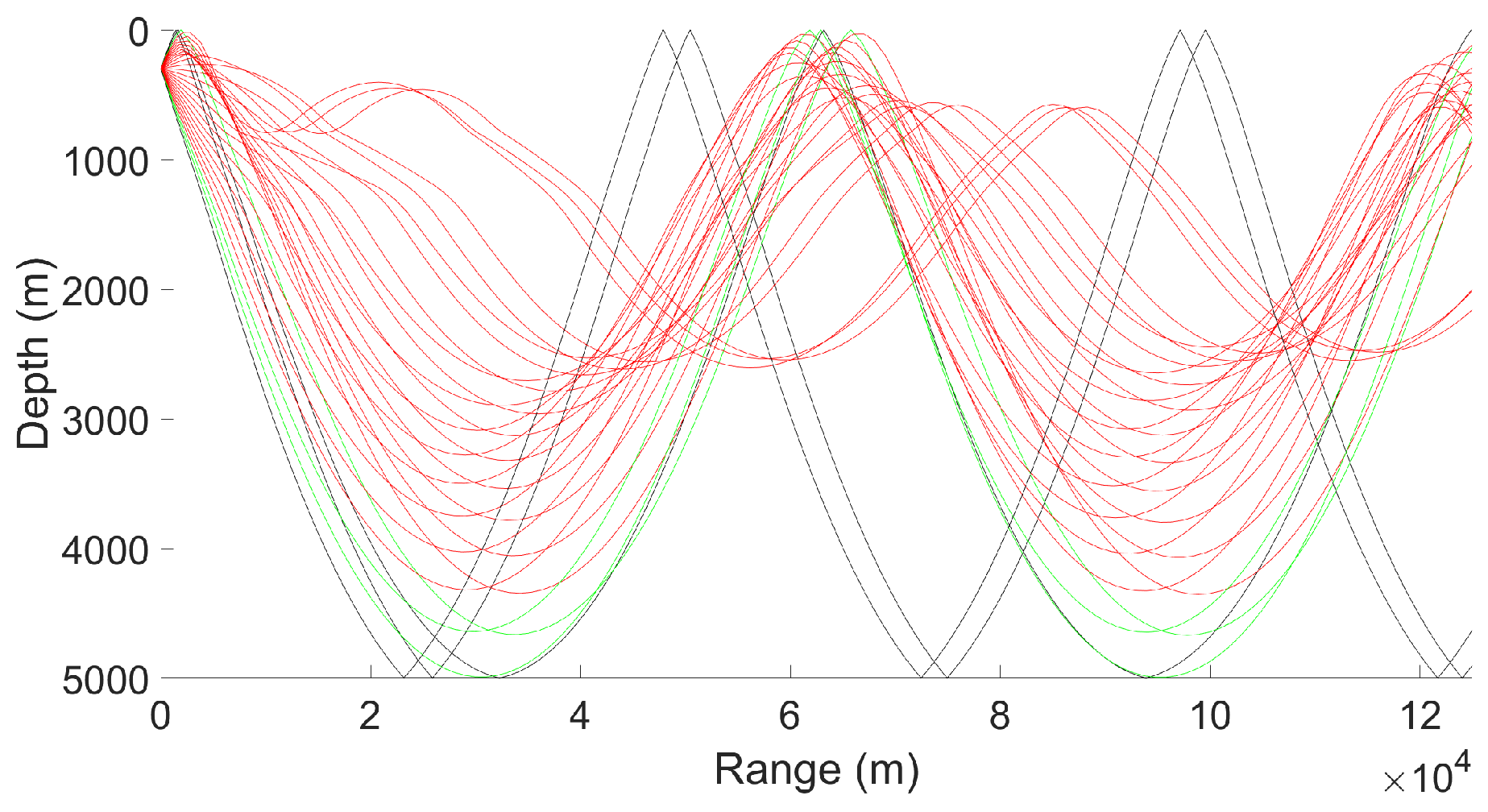
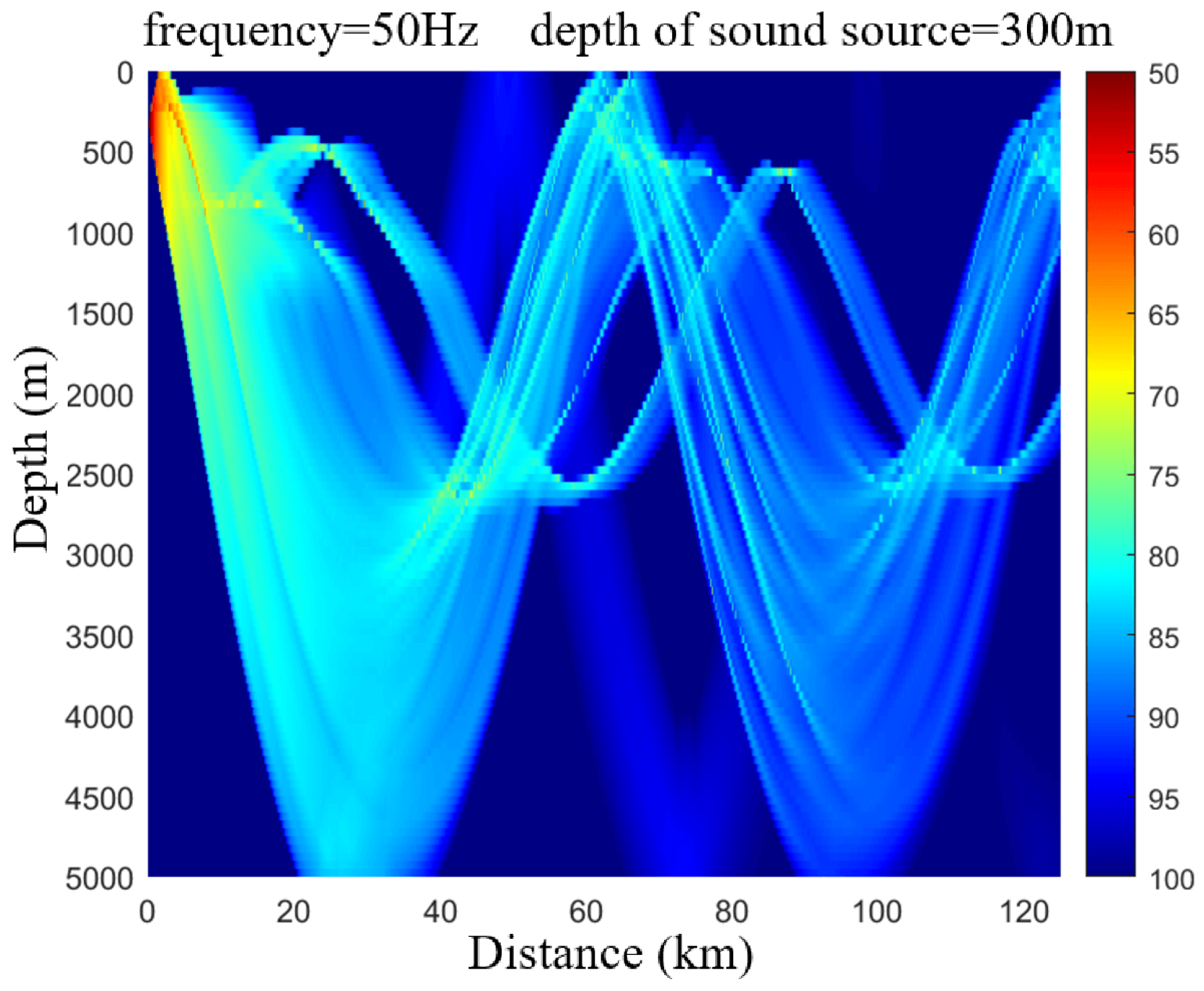
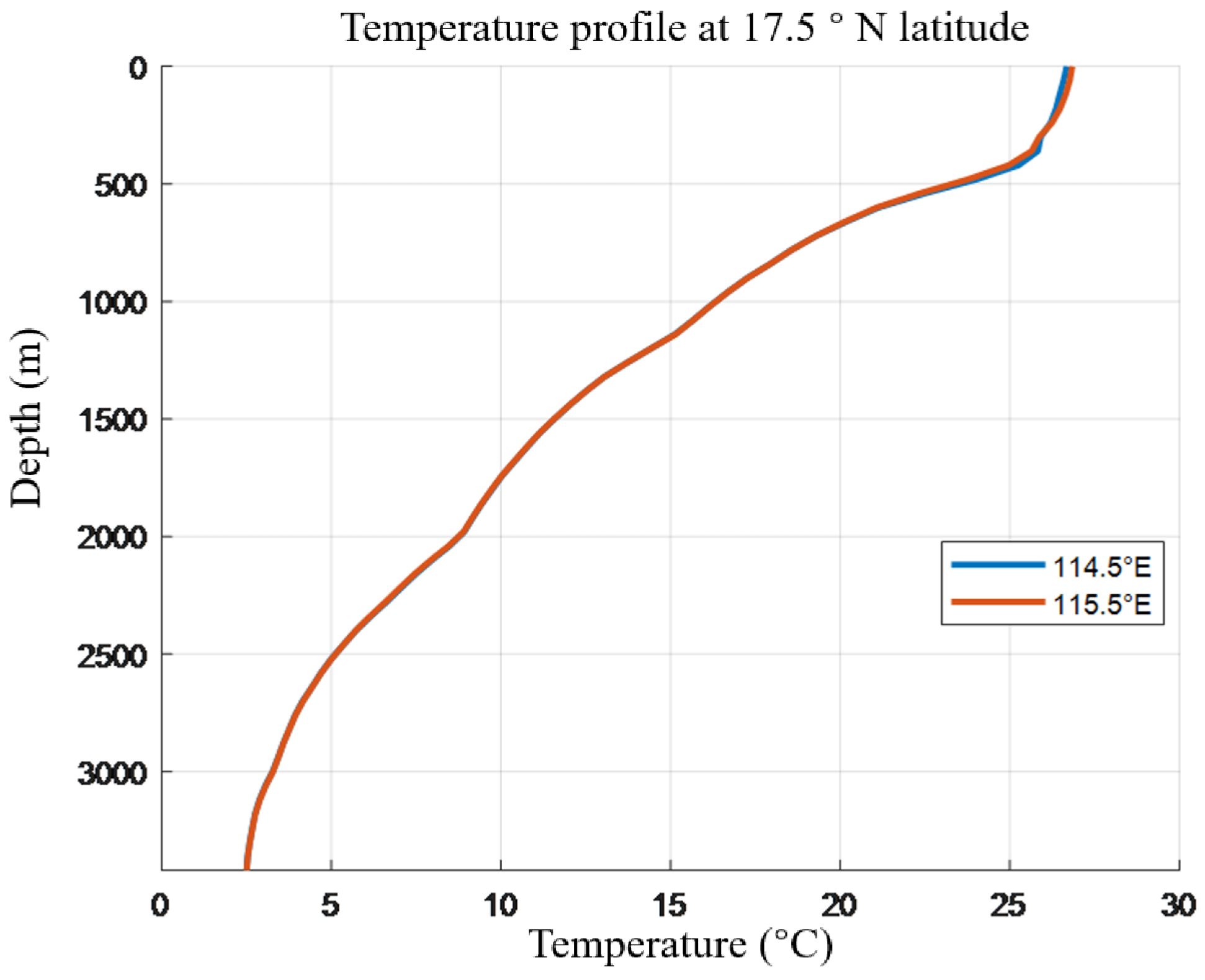
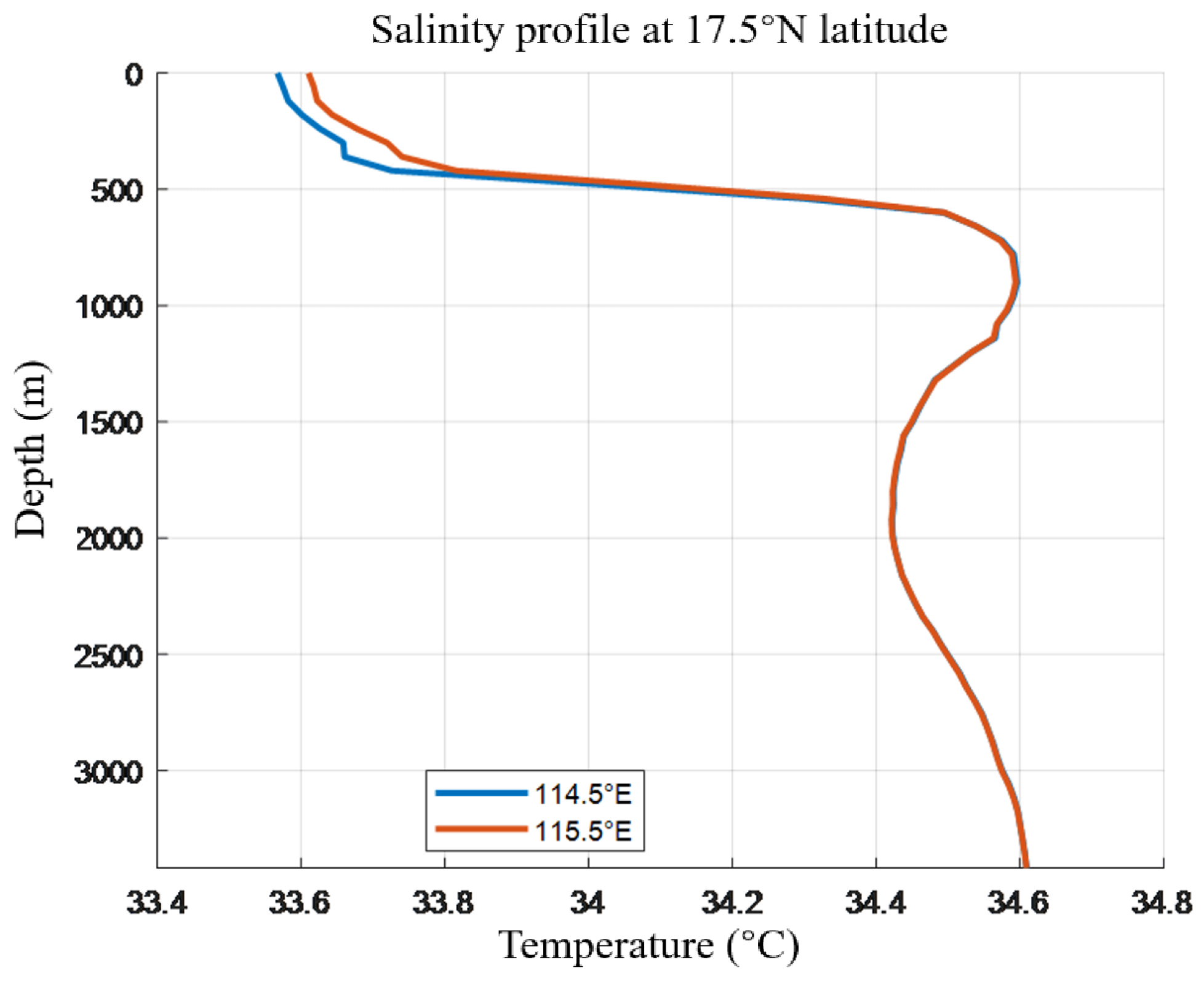
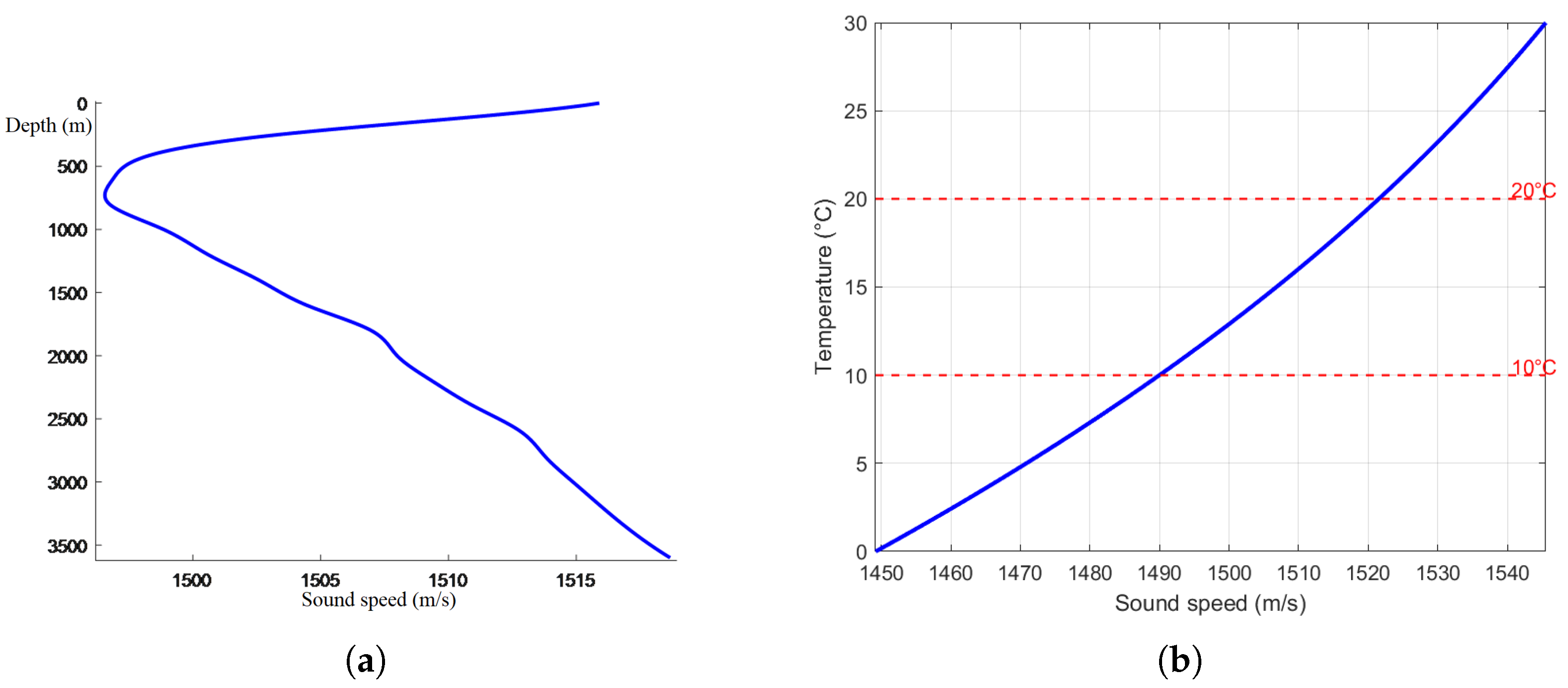
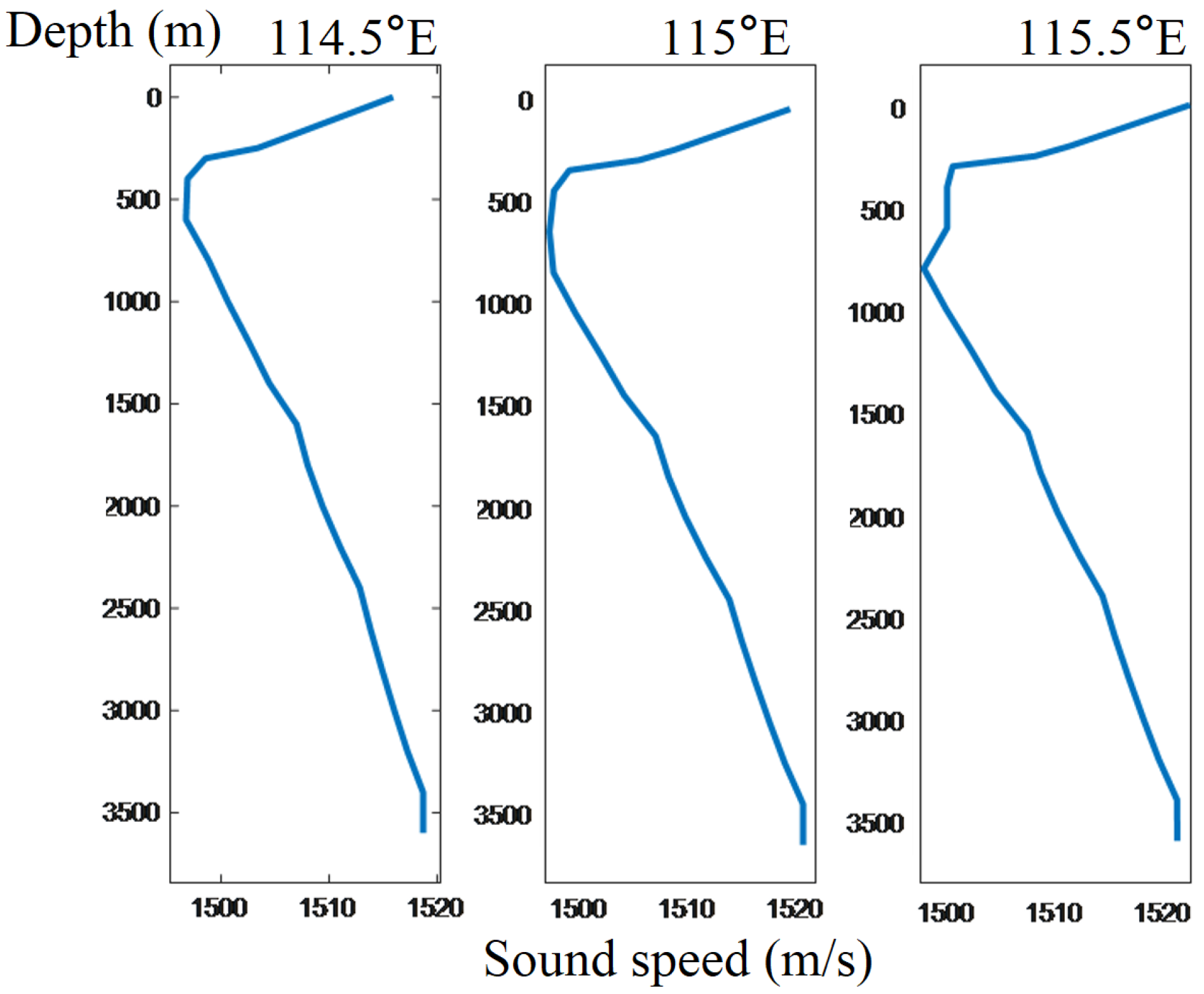
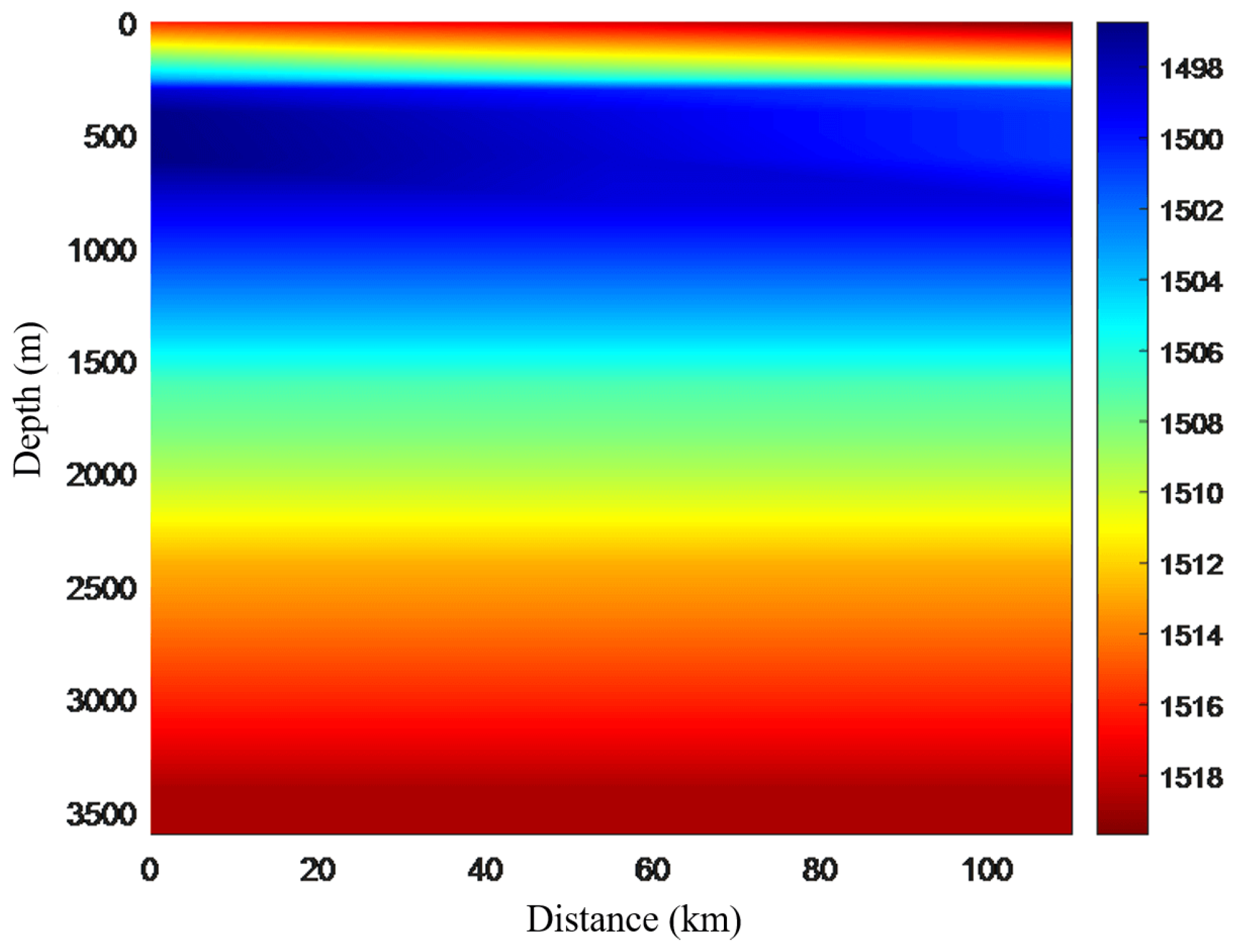
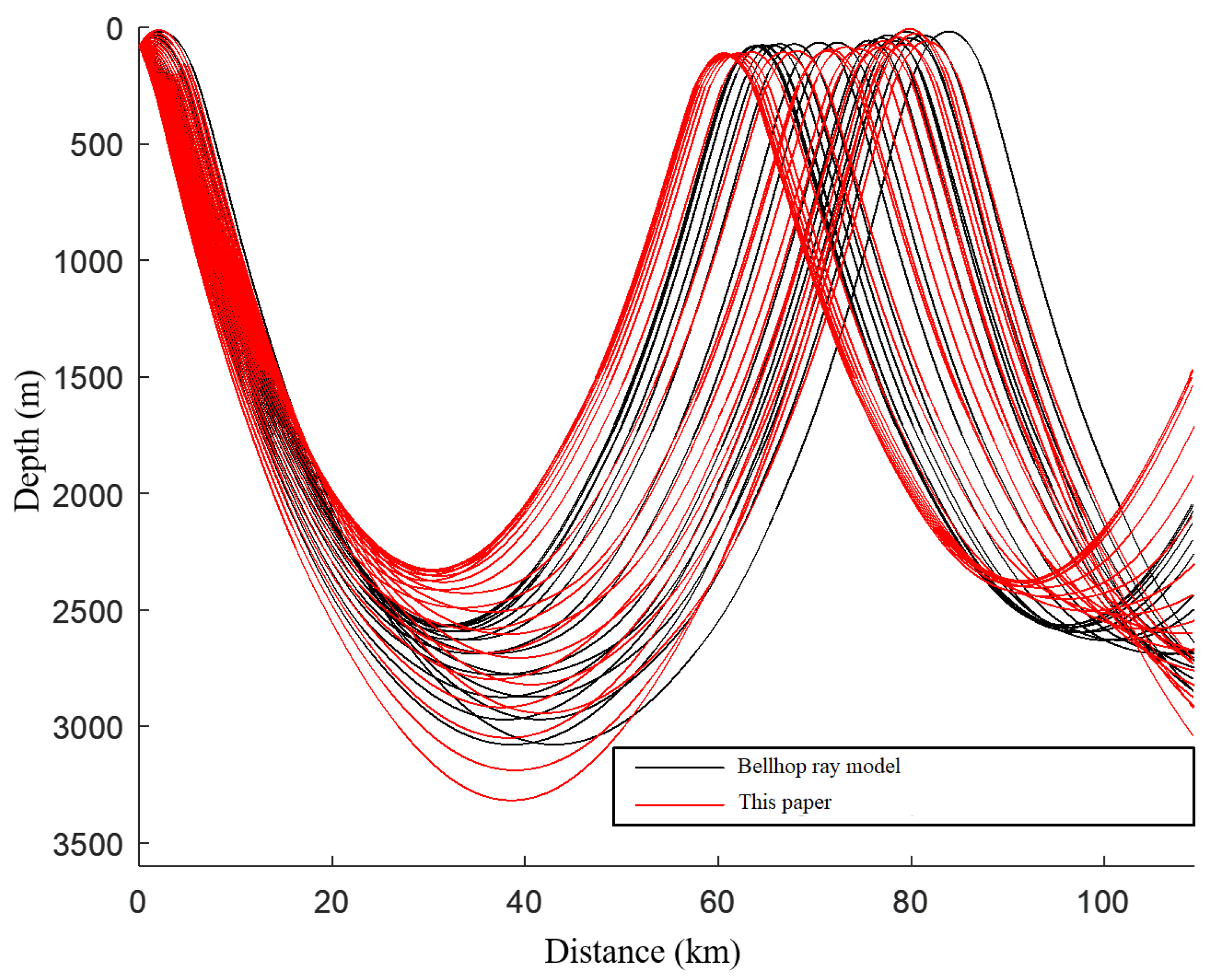
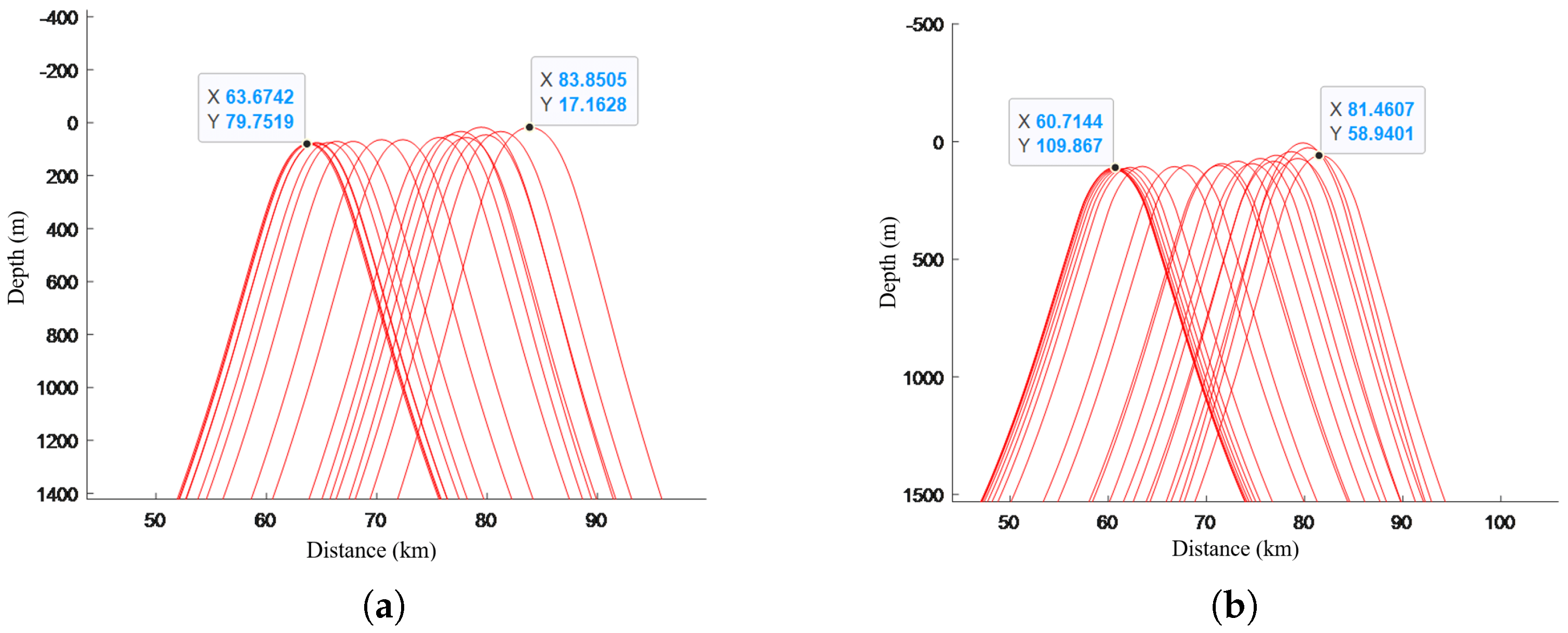
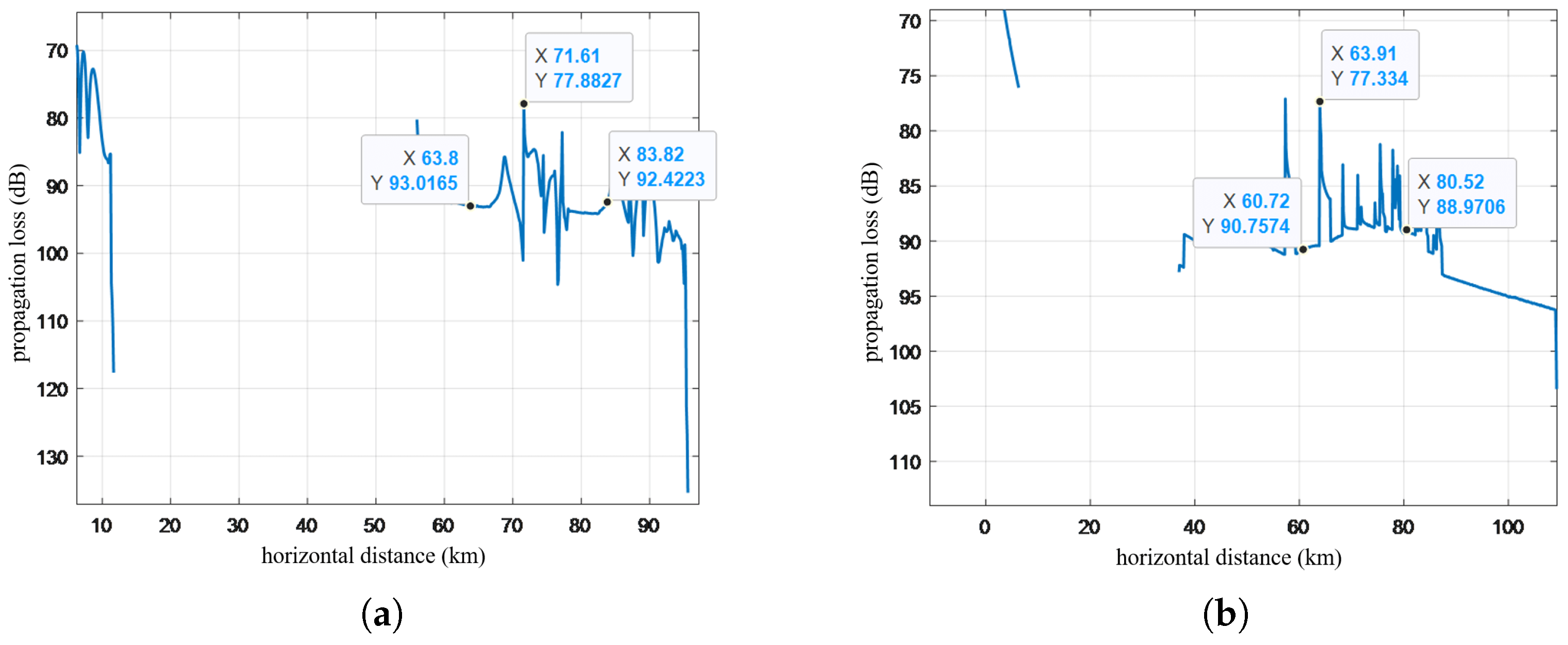
| Distance (km) | Width (km) | Gain (dB) |
|---|---|---|
| 61.5 | 21.4 | 13.5 |
| Method | Distance (km) | Width (km) | Gain (dB) |
|---|---|---|---|
| Measured | 61.5 | 21.4 | 13.5 |
| Bellhop | 63.6742 | 20.1763 | 15.12 |
| This article | 60.7144 | 20.7463 | 12.67 |
Disclaimer/Publisher’s Note: The statements, opinions and data contained in all publications are solely those of the individual author(s) and contributor(s) and not of MDPI and/or the editor(s). MDPI and/or the editor(s) disclaim responsibility for any injury to people or property resulting from any ideas, methods, instructions or products referred to in the content. |
© 2025 by the authors. Licensee MDPI, Basel, Switzerland. This article is an open access article distributed under the terms and conditions of the Creative Commons Attribution (CC BY) license (https://creativecommons.org/licenses/by/4.0/).
Share and Cite
Luo, G.; Zhao, D.; Zhou, H.; Guo, X.; Wang, H.; Fang, H.; Fang, C.; Xia, K. Deep-Sea Convergence Zone Parameter Prediction with Non-Uniform Mixed-Layer Sound Speed Profiles. J. Mar. Sci. Eng. 2025, 13, 1649. https://doi.org/10.3390/jmse13091649
Luo G, Zhao D, Zhou H, Guo X, Wang H, Fang H, Fang C, Xia K. Deep-Sea Convergence Zone Parameter Prediction with Non-Uniform Mixed-Layer Sound Speed Profiles. Journal of Marine Science and Engineering. 2025; 13(9):1649. https://doi.org/10.3390/jmse13091649
Chicago/Turabian StyleLuo, Guangyu, Dongming Zhao, Hao Zhou, Xuan Guo, Hanyi Wang, Heng Fang, Caihua Fang, and Kai Xia. 2025. "Deep-Sea Convergence Zone Parameter Prediction with Non-Uniform Mixed-Layer Sound Speed Profiles" Journal of Marine Science and Engineering 13, no. 9: 1649. https://doi.org/10.3390/jmse13091649
APA StyleLuo, G., Zhao, D., Zhou, H., Guo, X., Wang, H., Fang, H., Fang, C., & Xia, K. (2025). Deep-Sea Convergence Zone Parameter Prediction with Non-Uniform Mixed-Layer Sound Speed Profiles. Journal of Marine Science and Engineering, 13(9), 1649. https://doi.org/10.3390/jmse13091649






